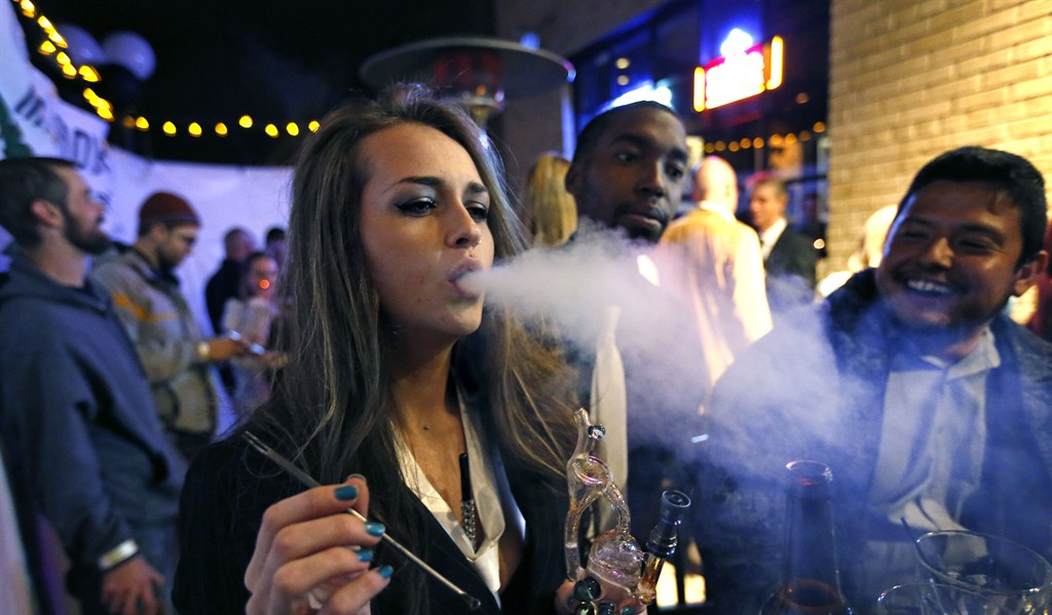“Prohibition is Over” bash in downtown Denver didn’t just raise their glasses to ring in 2014, they also lit up to celebrate the end of marijuana prohibition in their state.
At 8 am, when licensed stores were permitted to begin sales, hundreds waited eagerly in lines that wrapped around buildings and jubilant customers tweeted photos of their receipts. For better or worse, it was a truly historic day in our nation’s history.
Although 20 states currently allow medical marijuana, Colorado and Washington became the first to legalize marijuana possession for recreational use, and more than a dozen states are considering following suit. But while the push for liberalizing marijuana laws at the state level is gaining steam, not everyone is celebrating.
Against Legalization, by Leah Barkoukis
There is no question which direction public opinion is sway- ing on the marijuana legalization front. For the first time, a clear majority of Americans (58 percent) favor legalization, an October Gallup poll found—a drastic increase from the 12 percent who favored it in 1969 when the polling organization first asked the question. But public opinion doesn’t tell the whole story and shouldn’t be the determining factor in the debate.
Marijuana advocates contend that the drug is generally harmless and is no more dangerous than alcohol. President Obama even reinforced those beliefs in a recent interview with the New Yorker when he said that marijuana is “not very different from the cigarettes I smoked” and that he doesn’t “think it is more dangerous than alcohol.” These statements run contrary to his own administration’s position on the issue, however, and what science has found regarding the drug’s effects.
In 2010, R. Gil Kerlikowske, director of the Office of National Drug Control Policy, said that “marijuana legalization—for any purpose—is a non-starter in the Obama administration”—and for good reason.
A Dangerous Drug
Marijuana use affects one’s short-term memory, cognitive functions, coordination and balance, and in large doses, users can experience acute psychosis, which can include hallucinations and delusions, according to a National Institute on Drug Abuse report. These acute symptoms are proving to have a disastrous effect on driving, resulting in needless deaths and injuries when users get behind the wheel. Fatal car accidents involving marijuana have tripled in the last decade, a new study from Columbia University found—a problem that will likely escalate with an increased prevalence of marijuana use in society.
Research also shows that the drug’s negative effects on learning, memory, and attention can last for several days or even weeks after smoking. “Consequently,” the NIDA report states, “someone who smokes marijuana daily may be functioning at a reduced intellectual level most or all of the time”—not exactly an ideal outcome for a society already plagued by high unemployment.
In terms of users’ emotional wellbeing, marijuana use also increases the risk of depression and anxiety. Additionally, regular users may experience the same respiratory problems tobacco smokers do including lung infections and a diminished immune system, according to the National Institute of Health.
Many also assume that since marijuana is a ‘medicine’, it cannot possibly be bad for them. But marijuana remains a Schedule I controlled substance because it has “no currently accepted medical use,” a “high potential for abuse”, and a “lack of accepted safety.” The American Medical Association in November reaffirmed its opposition to marijuana legalization, retaining its official position that “cannabis is a dangerous drug and as such is a public health concern.”
Recommended
Despite the ‘non-addictive’ mantra advocates tout, long- term marijuana use can lead to addiction. Approximately nine percent of users (one in 11) become dependent. The drug is especially addictive for teenagers, increasing the odds to one in six; and for daily users, it ranges from between one in three and one in two. In 2007 alone, more than 110,000 people voluntarily went to treatment facilities reporting marijuana as their primary substance of abuse.
A Threat to Children
Although advocates are pushing legalization for adults, the debate in society cannot exclude the effect legalization will have on youth because, as it stands, roughly 46 percent of teens will have tried marijuana by the time they graduate high school, and according to researchers at the University of Michigan, nearly 5.5 percent of high school seniors smoke marijuana daily.
“We know that from prevention science ... teens are most likely to use things that are A, available and B, for which there is a low perceived harmfulness,” Dr. Christian Thurstone, medical director of a busy adolescent substance abuse treatment program in Denver, said in an interview with NPR. As the drug becomes legal in more places, medicinally or recreationally, availability will undoubtedly increase and the perceived harmfulness will only continue to diminish as public opinion and laws change. And young people are most vulnerable to marijuana’s adverse effects.
Aside from its more addictive nature in adolescents, marijuana is particularly harmful for developing brains, negatively affecting learning and memory, and in turn, one’s ability to successfully function in school, work, and family life. One study discussed in the Substance Abuse and Mental Health Services Administration’s 2013 TEDS Report shows that among regular adult smokers, those who began using marijuana in their youth lost up to eight IQ points, which were not restored in those who quit later in life.
“I see teenagers who choose pot over family, school, friends and health every day,” Thurstone wrote in The Denver Post. “When they’re high, these young people make poor choices that lead to unplanned pregnancies, sexually transmitted diseases, school dropouts and car accidents that harm innocent people. When teenagers are withdrawing from marijuana, they can be aggressive and get into fights or instigate conflicts that lead to more trouble.”
Legalization Won't Help
All this aside, advocates say the War on Drugs has failed, the cost of prohibition places a great burden on taxpayers and governments, and that law enforcement should instead use their resources more efficiently. This was one of the rationales given for legalization in Colorado.
The vast majority of people in state or federal prison for marijuana-related crimes are major traffickers and distributors, however. Of the drug defendants sentenced in federal court for marijuana offenses in 2012, only 1.2 percent were sentenced for simple possession, according to the U.S. Sentencing Commission.
Although there are criminal justice costs related to federal, state, and local marijuana laws, those costs will not necessarily be reduced and could possibly be exacerbated by legalization or decriminalization. For example, there were 2.5 million arrests in 2010 for alcohol-related crimes such as violations of liquor laws and driving under the influence—far more than the number of arrests for all illegal drug use. And since alcohol is of course a legal and highly regulated substance, legalizing or decriminalizing marijuana does not necessarily mean then that the burden placed on our justice system and law enforcement will be reduced.
There Are Other Solutions
Managing the use of marijuana through the criminal justice system is important, but admittedly shouldn’t be the only solution going forward. Prevention is critical and good programs in schools and communities are seriously lacking. Only 8 percent of U.S. schools use tested programs, according to a recent Department of Education report, with less than half of those implementing them well. D.A.R.E. is the most popular prevention program in schools even though studies have consistently shown it’s ineffective in reducing alcohol and drug use. Better programs must be created and they need to be implemented well and monitored for effectiveness. If such programs are implemented, RAND research shows that every dollar spent could save taxpayers $18 in avoided costs.
Yes, marijuana is the most commonly used illicit drug, but its use and effects would be worse today if it weren’t illegal. Alcohol has already caused so much destruction and dysfunction in society that we must ask ourselves why we’re rushing to expand the use of another substance with its own social and economic costs that will undoubtedly be borne by society.
For Legalization, by Christine Rousselle
Prohibitions on marijuana have existed in some form in the United States since the 1860s, with a wide federal ban on the sale, consumption, transportation, or production of the substance enacted in the 1930s. The War on Drugs began in 1971, and government has spent trillions fighting various substances, including marijuana.
A Losing War
A pro-marijuana billboard is seen near the Denver Broncos stadium in Denver September 5, 2013.
These prohibitions have failed to prevent people from using marijuana. According to a 2013 Gallup poll, 38 percent of adults in the United States report trying marijuana at least once, with 49 percent of respondents ages 30-49 admitting that they have used the drug at some point. These numbers are a slight increase from 34 percent in 2001.
If anti-drug advocates would like to see the percentage of people using marijuana decrease, they should look to the successes the anti-tobacco lobby has had. Rates of tobacco smoking are at all-time lows, with fewer than one out of five adults now smoking. The percentage of adults who smoke cigarettes has decreased substantially since 1997, when nearly a quarter of all adults were regular smokers. While laws have been passed that restrict the areas a person can smoke tobacco and taxes have been imposed on the substance, it still remains legal. Other factors besides outright prohibitions have pushed people away from cigarettes.
One commonly cited reason against the decriminalization of marijuana is that children and teens will have increased access to the drug. Newsflash: children and teens already have access to the drug and are using it at increasingly high rates despite the prohibition of its sale, consumption, and production. Since 2002, a plurality of teens surveyed by the National Center on Addiction and Substance Abuse reported that marijuana is easier for them to buy than beer, with 25 percent of teens saying that they could access marijuana within an hour. Just as the current laws have not stopped adults from consuming marijuana, they have not stopped children or teens from smoking as well.
According to the Community Anti-Drug Coalitions of America’s annual Monitoring the Future survey more than one third of the 12th graders have tried marijuana within the last year, and about 6.5 percent, or one out of every 15, high school seniors smokes marijuana daily. Further, a full 60 percent of 12th graders said that they did not view marijuana as harmful. These figures are either increased or constant from the 2012 survey.
Other studies have shown similar results. The Centers for Disease Control and Prevention surveys high school students every other year on drug, alcohol, and other risky behaviors in its Youth Risk Surveillance System survey. In 2011, the most recent year statistics are available, 23.1 percent of surveyed students admitted to smoking marijuana in the 30 days prior to taking the survey, which was an increase from 20.8 percent in 2009.
A Better Tactic
Compare those figures to the CDC’s finding that 18.1 percent of students who admit to smoking tobacco the month prior to the survey, which was a decrease from 19.5 percent of students in 2009. The percentage of high school students who admit to smoking cigarettes has been trending downward in the past decade—in 1999, 34.8 percent of those surveyed admitted to smoking. These lower figures exist even though purchasing and smoking tobacco is legal for people over the age of 18.
The War on Drugs has been a complete failure and a waste of money. In 2008, the government spent more than $3 billion fighting marijuana consumption and production. Unfortunately use continues to increase and more people now believe the drug is not harmful. A person is arrested every 19 seconds for some form of drug-related offense in the United States (although many of those arrests are admittedly related to substances other than marijuana). And of those, more than eight out of 10 are for possession of a drug alone. This is an incredible waste of resources by police forces.
“The time that police officers spend chasing drug dealers and users is time not spent catching murderers, thieves, and rapists. Prison space used to house drug dealers and users is space not available for other more serious criminals,” explained Dr. Angela Dills, a professor of economics at Providence College. Roughly four out of 10 murders in the United States remain unsolved, along with 60 percent of rapes and 90 percent of burglaries, according to the Department of Justice.
Simply banning a substance does not eliminate a market for it, but rather drives the market underground into a black market. A black market removes consumer and seller protections that exist in the legal market—basically letting everyone fend for themselves. In a black market, there is no legal protection or outlet for a consumer or seller who gets ripped off, which oftentimes leads to dealers or users violently settling disputes or arguments. According to Dills, the homicide rate is approximately “25 to 75 percent higher” than it would be in the absence of drug prohibition.
Other Legal Substances Are Worse
The history and reasons behind marijuana’s initial federal criminalization in the 1930s is dodgy at best. Marijuana is currently classified as a Schedule I drug by the United States Controlled Substance Act—the same level as heroin and other dangerous opiates. Heroin overdoses kill thousands of people each year, while the National Institute of Health says on its National Drug Free Week website that the chances of death from a marijuana overdose is “not very likely.” These facts have led a bipartisan group of 18 members of Congress to request that Attorney General Eric Holder reclassify marijuana’s drug status.
It should not be inferred that marijuana is a perfectly harmless substance—it is not. There are significant health effects associated with regular use. However, this should not be grounds for the outright and continued criminalization of the drug. Plenty of harmful substances are legal: alcohol, tobacco, and the hallucinogen salvia divinorum are all legally sold in the United States yet are not exactly what one would refer to as healthy. Marijuana prohibition should end, and there should be honest awareness campaigns to educate people about the drug and its effects if people truly want to reduce consumption.
If tobacco rates can be effectively halved within two decades, it certainly is feasible to replicate that success with marijuana. While it may not make sense to legalize something in order to reduce the consumption of it, a well-regulated system is far superior to the current system of black markets and violence.
Marijuana legalization has been a controversial issue for more than a century. While the tide is certainly turning in the favor of the pro-legalization crowd, especially with Colorado and Washington’s recent passage of legalized recreational marijuana, this issue will likely be debated for years to come. •























Join the conversation as a VIP Member